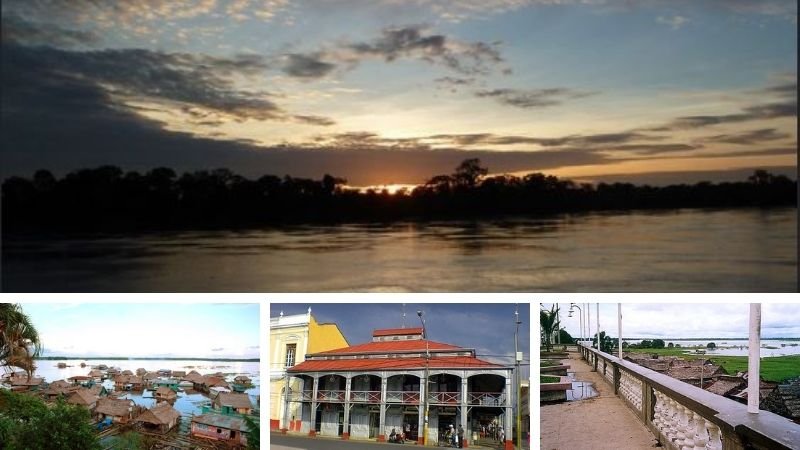
The foundation of Loreto as a department is in 1866. It is located in the extreme northeast of Peruand belongs to the Amazon Plain.
Its area is 368,852 km2, sharing a 3,891 km2 border with three countries: to the northwest with Ecuador, to the northeast with Colombia, and to the east with Brazil(Banco de la Reserva Central del Perú, 2018).

Así mismo Loreto se divide en 8 provincias y 53 distritos. These provinces are: Alto Amazonas, Datem del Marañon, Loreto, Mariscal Ramón Castilla, Maynas, Requena, Ucayali and Putumayo. These provinces are: Alto Amazonas, Datem del Marañon, Loreto, Mariscal Ramón Castilla, Maynas, Requena, Ucayali and Putumayo.
According to the National Institute of Statistics and Informatics (INEI), in 2017 the population of Loreto reached 883,510 inhabitants (Banco de la Reserva Central del Perú, 2018).
Cities of importance in Loreto
In its capital, Iquitos, it has historic buildings from the era of the rubber barons‘ heyday (1879-1912).

Sascha Grabow www.saschagrabow.com, CC BY-SA 3.0
As well as natural tourist attractions typical of the Peruvian Amazon, with great biodiversity, having a tropical forest setting and the hydrographic network of the region, especially the Amazon River.
Among the main tourist attractions of the department of Loreto stand out (Banco de la Reserva Central del Perú, s.f):
Natural reserves
- Pacaya – Samiria National Reserve, also known as Selva de Los Espejos, is located 183 kilometers southwest of Iquitos, it is considered the largest flooded forest in the Amazon. It was declared a national reserve in 1982.
- Allpahuayo – Mishana National Reserve created in 2004, in order to protect one of the largest white sand forests in the Peruvian Amazon. It has more than 58,000 hectares belonging to the Mishana community, in the province of Maynas.
Architecture and Museums
- Iquitos Cathedral, in neo-Gothic style, was built between 1911-1924, located in the Plaza de Armas of the city of Iquitos.
- Casa de Fierro, in front of the Plaza de Armas of Iquitos, was built in 1887 as a testimony of the splendor of the rubber era, it was designed by the French architect Gustavo Eiffel.
- Former Hotel Palace, located between the corners of Putumayo Street and Malecón Tarapacá. It was completed in 1912, considered the best and most luxurious in the Peruvian Amazon, with balconies and iron bars from Hamburg; Carrara marble and Sevillian and arabesque mosaics.
- Municipal Museum and Amazon Library The Museum, which preserves and exhibits a varied sample of jungle fauna and handicrafts from the different indigenous ethnic cultures. Located a few steps from the Plaza de Armas in Iquitos. The Library is one of the most important in Latin America on the Amazon.

Percy Meza, CC BY-SA 3.0
Places of interest
- Malecón Tarapacá, located on the banks of the Amazon River, dates from the time of the rubber boom. During its tour it offers a panoramic view of the Amazon River and the port of Belén.
- District of Belén, known as the Peruvian Venice, because the houses rise above the flow of the Amazon River.

Håkan Svensson (Xauxa), CC BY-SA 3.0
References
- Banco de la Reserva Central del Perú. (2018). Caracterización del departamento de Loreto, recuperado de https://www.bcrp.gob.pe/docs/Sucursales/Iquitos/loreto-caracterizacion.pdf.
- Banco de la Reserva Central del Perú. (s.f.). Loreto: principales atractivos turísticos, recuperado de https://www.bcrp.gob.pe/docs/Sucursales/Iquitos/Loreto-Atractivos.pdf.

Economist (Central University of Venezuela). Full professor and researcher attached to the “Edgar Abreu Olivo” Agrifood Research Center, Universidad de Los Andes. Doctor from the University of La Laguna (Spain). Award “One of the 10 most consulted authors of the Saber ULA university portal” (2005); prize in the III Essay Contest of the Central Bank of Venezuela BCvoz Economico, 2016, with the work “Theobroma cacao: transformation and consumption of the “food of the gods” in Venezuela and the world” (co-authored).
This post is also available in:
![]() Español (Spanish)
Español (Spanish)
